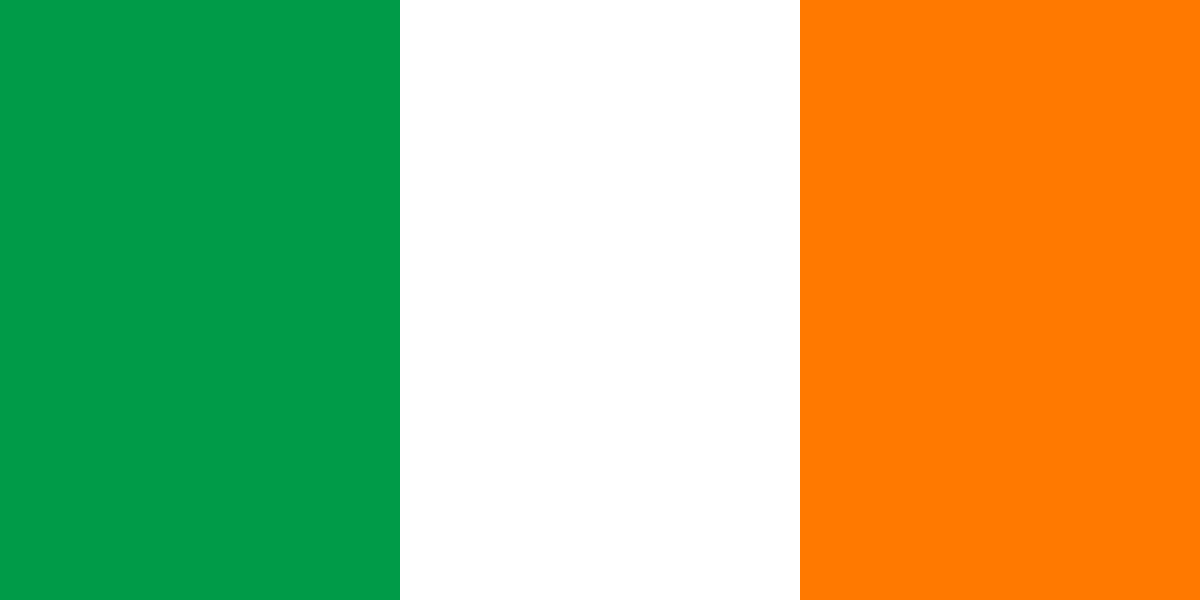Historical Context:
The emergence of the Irish flag was intertwined with a turbulent period of political and societal transformation in Ireland. Amid the mid-19th century, Ireland grappled under British dominion, while an escalating movement for Irish nationalism and self-rule took root. The flag's conception drew inspiration from these ideals, serving as a poignant embodiment of the vision for a united and sovereign Ireland.
Green Stripe (Hoist Side):
The verdant green stripe transcends its representation of the Catholic community, extending its significance to the very fabric of the Irish landscape and the nation's profound affinity with its natural environs. Historically enmeshed in Irish culture, folklore, and the tapestry of identity, the color green is emblematic of hope, growth, and the indomitable essence of the Irish populace.
White Stripe (Middle):
Serving as a harmonious bridge between the green and orange stripes, the white expanse signifies a resolute yearning for peace and concord within the divided segments of Ireland's populace—the Catholic and Protestant communities. White serves as a canvas upon which the aspiration for unity, empathy, and a shared destiny among all Irish individuals is artfully painted.
Orange Stripe (Fly Side):
The orange stripe, emblematic of the Protestant community, delves into the historical tapestry of the late 17th century's Williamite War in Ireland. The hue resonates with the supporters of King William III of England, a prominent Protestant figure. Inclusion of the orange stripe within the flag's composition represents a nod to this heritage, capturing the intricate historical nuances of Ireland.
Proportions and Usage:
The Irish flag adheres to a harmonious proportion of 1:2, signifying that its length is precisely double its width. Each stripe boasts equitable breadth, though the green stripe holds a subtle prominence over its orange counterpart. The flag adorns flagpoles in diverse public and private spaces, spanning government edifices, educational institutions, and official ceremonies, exuding its emblematic resonance.
Symbolism of Unity and Peace:
The triadic configuration of the flag unveils a profound symbolism of an all-encompassing and harmonious Ireland, wherein disparate communities coalesce in tranquility. The tricolor amalgamation of green, white, and orange forms a potent visual testament to the yearning for reconciliation and the cessation of historical schisms.
International Significance:
The Irish flag has transcended national borders to attain global recognition as a quintessential emblem of Ireland and its populace. Its unfurling during international festivities, such as exuberant St. Patrick's Day celebrations, mirrors its ubiquitous presence amongst the Irish diaspora worldwide. The flag perpetuates the legacy of Ireland's narrative, heritage, and the relentless pursuit of a luminous future.
Evolution and Adoption:
The flag's evolution is marked by a series of iterative metamorphoses before crystallizing into its contemporary tricolor configuration. Its assimilation within Irish national identity and the panorama of self-determination bears pivotal historical resonance. The flag's elegantly unembellished yet evocative design endures across generations, resonating profoundly within the Irish populace and beyond.
In summation, the Irish flag embodies a meticulously crafted emblem that encapsulates a multifaceted historical saga, an ardor for unity and tranquility, and the enduring vigor of its people. Its distinctive design, infused with vibrant hues, serves as a formidable symbol of Irish identity, resounding within the heartland and traversing the globe.
Last Updated on: August 09, 2023